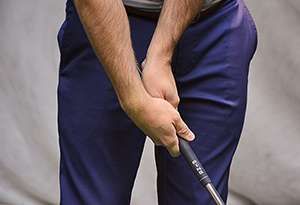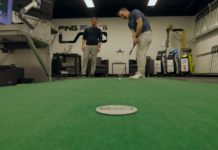Learn some of the most common – and vague – golf instruction terms and what they often mean
By Jon Levy
It can get downright frustrating.
No, not the game of golf. Though, of course the game has its moments.
Golf instruction.
Not instruction itself, mind you. We’re confident that, at GolfTEC, we lead the pack when it comes to how to help people play better golf.
Golf instruction terms, though – since many are thrown around freely, ambiguous and carry different meanings – can be an extremely frustrating component to the game.

Here’s an example:
“I know I need to work on my lag, tempo, footwork, feeling grounded and squaring my clubface while I clear my hips to get rid of the over-the-top casting and premature release during my overly rushed – and poorly timed – downswing.”
I’m exhausted after just writing it, much less apt to think this golfer has a shot at accomplishing said objectives.
The point is that golf is already hard enough, and it gets more difficult when swing and instruction terms are not clearly defined and explained. Because it’s then it up to the golfer to translate subjective meanings into what he or she thinks is happening, or needs to happen. Which is, naturally, is a disaster waiting to happen.
So, enough is enough. Let’s finally make sense of golf instruction terms – or at least give a solid stab as to what they often mean – so you can have a better idea what to do next time you feel the need to work on “grounding yourself.”
Vague and ambiguous golf instruction terms

Squaring, opening or closing the clubface
Relating to target: Having a square clubface means the club’s grooves are positioned at a perpendicular (90-degree) angle to the intended target.
An open clubface (for a right-hander) would be aimed to the right, and a closed clubface would be aimed to the left.
Relating to swing path: A square clubface takes the same idea of being perpendicular to line of target, but relates its position to swing path.
For example, if the clubface is open to swing path – and we know through an understanding of golf ball flight laws this relationship will cause a ball that curves to the right – the clubface must be closed or “squared up” during the downswing to eliminate that curvature.
Lag
Having “lag,” in simple terms, often refers to the angle/hinge created between the lead arm and club in the backswing that is maintained in the downswing to create an ideal position at impact.
The term is often used around the idea of creating “more lag” in the downswing, noting to a positive change that will create better ball striking with an ideal low point of the swing and ball-first contact.
Casting
The opposite of lag. Or, when that angle between the lead arm and the club in the backswing “unhinges” too early in the downswing, which causes a loss of potential clubhead speed and often poor contact.
Shown in this image with a student featured in our series on Golf Channel, her “casting” of the club is compared to have more lag in the before/after swing comparisons.
Scooping or flipping
A common effect of casting the club in the downswing, the “scoop” or “flip” generally refers to an undesirable position at impact if the flexed lead wrist and extended trail wrist lose their angles in the downswing.
As seen in this image, these wrists denote a classic scooped/flipped shot, which often results in fat or thin contact.
 Clearing
Clearing
Generally refers to the opening or “unwinding” of the hips in the downswing into impact.
As noted by the GolfTEC SwingTRU Motion Study, tour pros have opened their hips an average of 36 degrees at impact, as compared to 30 handicappers who contact the ball with their hips just 19 degrees open.
Swaying
A term referring to the lateral movement or “shift” of the hips toward or away from the target during the swing, golfers are often told to “stop swaying” their hips in the backswing.
Relating the thought to this SwingTRU Motion Study image denoting hip sway, it can be seen how professional golfers at the top of the backswing position their hips 1.6 inches more toward the target than 30 handicaps. It’s this relationship where most of the “stop swaying” phrases originate from.
Covering
Typically refers to some combination of hip sway and hip turn at impact – though many golfers’ connotations of “covering the ball” can vary greatly.
Some of the most common usages occur when the hips are positioned too far away from the target at impact, like in this SwingTRU Motion Study image noting differences between hip movement at impact with a 30 handicap and professional golfer.
Tempo
 Often used together with “timing” or “rushing,” these ambiguous terms are used to approach the sequencing of the swing. Here’s an example of something you may have heard your buddies say before:
Often used together with “timing” or “rushing,” these ambiguous terms are used to approach the sequencing of the swing. Here’s an example of something you may have heard your buddies say before:
“You rushed your downswing, so you casted the club and then couldn’t cover the ball correctly. Try slowing your tempo down and timing this move better.”
A better way to perhaps translate these time-focused words could be by thinking about the sequence – a step-by-step, cause-and-effect relationship – of events occurring in the swing.
Relating to that statement in this manner, the player may be helped by focusing on a bigger hip and shoulder turn in the backswing, instead of discerning various meanings on how to stop “rushing” and “timing” the swing better.
Footwork
 When “footwork” is brought up, it often refers to a shift in weight, or the sequence of movement in a shift in weight, throughout the golf swing.
When “footwork” is brought up, it often refers to a shift in weight, or the sequence of movement in a shift in weight, throughout the golf swing.
Having poor footwork is often identified when the golfer’s hip sway is too far away from the target at impact, and that he or she needs to “get over to the lead side with better footwork” by shifting most of the weight onto the lead foot in the follow-through and finish.
Releasing
 It’s easy to think this term is clearly defined and should fall into the ‘more defined’ category.
It’s easy to think this term is clearly defined and should fall into the ‘more defined’ category.
But – as to the crux of this entire article – there can be many common definitions to “releasing,” thus epitomizing why golf instruction terms can get so frustrating.
For example, is releasing in context to the hands? The forearms? Some other part of the body?
And is this supposed to be accomplished by “flipping” the hands over? “Turning” the hands over? “Rolling” the forearms?
The point is that while this term generally refers to a version of creating an ideal impact position with the clubface, there are many ways it can be defined and translated. Which, of course, can lead to trouble as a golfer trying to understand how to improve release in their swing.
Just the facts, please!
Golf is hard enough as it is, without adding the element of multiple meanings with golf instruction terms and slang. It’s no wonder why so many struggle to improve at the game in this regard.
But, while we may have just scratched the surface when it comes to vast sea of vague and ambiguous golf instruction terms, the point – akin to GolfTEC’s philosophy of having a standardized system to eliminate this confusion (and with a final jab on context within language) – is simple:
Stick to the facts for a better shot at hitting better shots.
Related:
Ready to make even more sense of these terms? Find a GolfTEC near you and talk to a Coach today!











